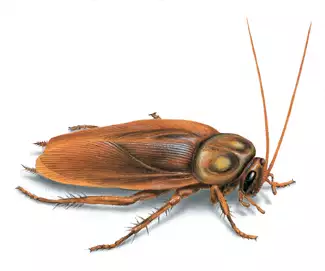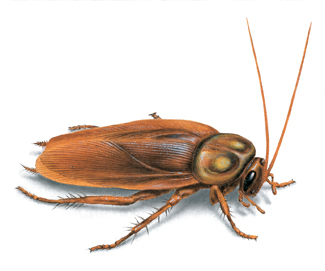- Contact
- 01211118453
- Send Email
- info@spider-eg.com
American Cockroaches

American Cockroaches Facts & Information
How To Identify & Control American Cockroaches
Latin Name
Periplaneta americana
Appearance

Length: Adults can be slightly more than 50 mm (3 inches) long.
Color: Adult American cockroaches are reddish brown or mahogany colored. The area behind their heads is outlined with a yellow band.
Reproduction
Female American cockroaches make protective cases for their eggs. These cases are capsule-shaped. After forming a capsule, the roach deposits it in a warm, humid area. An average American roach egg capsule contains about 16 eggs.
When the eggs hatch, the tiny nymphs come out of the capsule. As they grow, the baby cockroaches shed their skins. If there is plenty of food, American cockroaches can develop from egg to adult in as little as 5½ months.
Behavior & Diet
Both male and female American cockroaches can fly. The wings develop when the roaches become adults.
American cockroaches normally live outdoors. They prefer warm, damp areas like flowerbeds, and under mulch. In many parts of the United States people call them “palmetto bugs” because they live on trees. American cockroaches are very common in sewer systems of many American cities.
American cockroaches enter homes to find water or food. They can easily pass under doors if the weather stripping is damaged. Basement windows and garages are also common entryways. When American cockroaches enter homes, they often go to bathrooms, kitchens, laundry rooms and basements.
Outdoors, American cockroaches eat leaves, tiny wood particles, fungi and algae. They also eat small insects. Indoors, American cockroaches forage under appliances, in drains, in kitchen cabinets and on the floor. They eat crumbs, scraps of food and spilled food that they find. They will also eat pet food that is left out overnight.
Signs of American Cockroach Infestation
Sightings
Homeowners may see these active cockroaches. American roaches can run very fast, and they usually scurry into a dark area. If they are startled, American roaches may even fly.
Droppings
American cockroaches leave their droppings in the dark areas where they hide. Homeowners may find these droppings in basements, in pantries or behind appliances.
American cockroach droppings are small, and sometimes people mistake them for mouse droppings. American cockroach droppings have ridges on the sides and they are blunt on the ends. Mouse droppings have pointed ends. Since mice groom themselves, mouse droppings often have hairs embedded in them.
Egg Capsules
American cockroach egg cases are about 38 mm long. They are dark-colored—reddish or blackish brown. Homeowners often find these egg cases in basements, in laundry rooms or kitchens. The egg cases may be under cabinets or behind appliances. American cockroaches also deposit their egg capsules behind stored items in garages and sheds.
Odor
Cockroaches produce a chemical called an “aggregation pheromone.” The odor of this chemical causes the roaches to stay together in groups. Some people describe the odor of these pheromones as having a “musty” smell. As the roach population starts to grow, people with sensitive noses may begin to notice this odor.
How Did I Get American Cockroaches?
American cockroaches enter home to find water or food. They can easily pass under doors if the weather stripping is damaged. Basement windows and garages are also common entryways. When American cockroaches enter homes, they often go to bathrooms, kitchens, laundry rooms and basements.
How Serious are American Cockroaches?
Cockroaches are filthy pests. They can spread disease, contaminate our food and cause allergies and even asthma. Cockroaches can pick up germs on their legs and bodies as they crawl through decaying matter or sewage and then transfer these germs to food or onto food surfaces. According to the World Health Organization (WHO), they are proven or suspected carriers of the organisms causing diarrhea, dysentery, cholera, leprosy, plague, typhoid fever and viral diseases such as poliomyelitis.
Orkin encourages people to help reduce cockroach populations by removing all food and unnecessary water sources, sealing all cracks and crevices, vacuuming and removing shelter sites like cardboard and paper. To effectively manage a serious cockroach infestation, you must correctly identify the type of cockroach causing the infestation, which is why it is important to contact a pest control professional.

